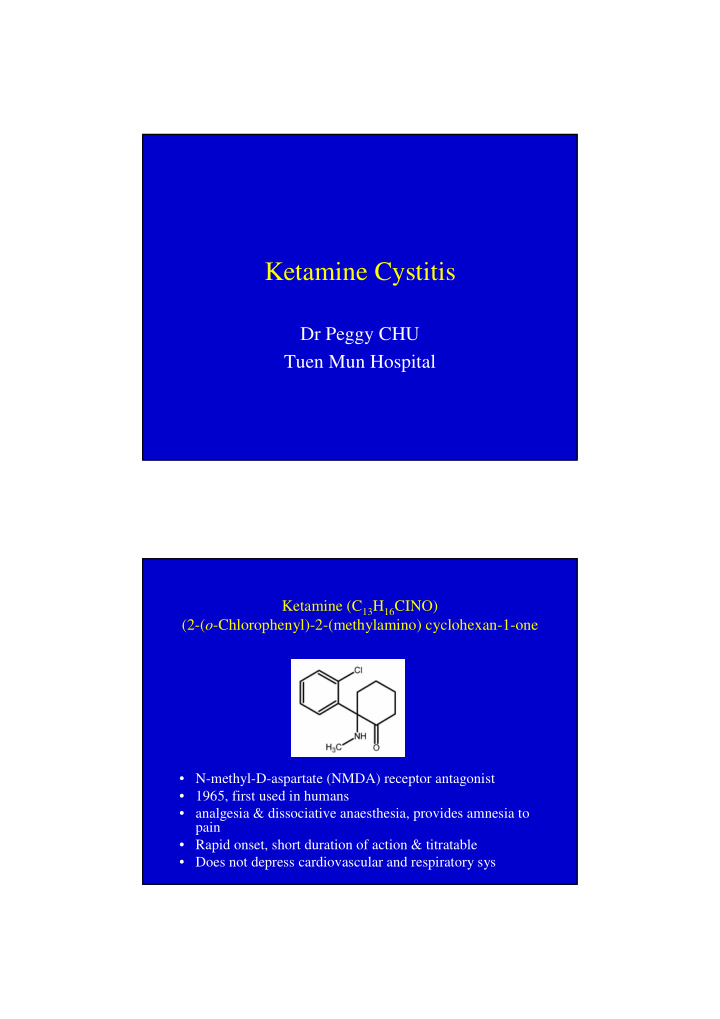



Ketamine Cystitis Dr Peggy CHU Tuen Mun Hospital Ketamine (C 13 H 16 CINO) (2-( o -Chlorophenyl)-2-(methylamino) cyclohexan-1-one • N-methyl-D-aspartate (NMDA) receptor antagonist • 1965, first used in humans • analgesia & dissociative anaesthesia, provides amnesia to pain • Rapid onset, short duration of action & titratable • Does not depress cardiovascular and respiratory sys
Ketamine • onset – 3 – 5 min (IMI) – 60 s (IVI) • duration of action – 20 – 30 min (IMI) – 10 – 15 min (IVI) • N-dealkylated in liver, metabolized and excreted in urine (>90%) Hong Kong Statistics Central Registry of Drug Abuse 58 th Report
HK’s first 10 cases of ketamine cystitis Hong Kong Med J 2007; 13: 311 – 3 Introduction Hong Kong Med J 2007; 13: 311 – 3
Patients • TMH • Sep 2006 - Jun 2010 • 113 patients • M: F = 90: 43 • mean age 25.6 yrs (14 – 42) • years of ketamine abuse: 3/12 to 11 years • referred by A&E, GP, psychiatrist • C/O: LUTS+ve Lower Urinary Tract Symptomatology • frequency, urgency, dysuria, urge incontinence, painful haematuria • urine culture –ve • no response to multiple courses of oral antibiotics
Urodynamic evaluation • 56/113 • Cystometric capacity 14 – 600 ml – 42/56 � 150 ml – 30/56 � 100 ml • 6/56 bilateral vur
Urodynamic Urodynamic • uni/bilateral vur
Cystoscopic Findings • 65/113 had cystoscopy • 25/65 – various degrees of mucosal inflammation – glomerulations Cystoscopic findings A B
Cystoscopic findings Upper Urinary Tract • blood creatinine • +/- hydronephrosis • papillary necrosis • ureteric stricture
Blood Creatinine • 10/113 – Creatinine 126 - 1069 – 2 required PCN
Upper Tract Radiology • all have renal USG – 30% bilateral hydronephrosis – 10% unilateral hydronephrosis Upper Tract Radiology • 2 bilat PCN x ARF
Upper Tract Radiology • all have renal USG – 4/113 sonographic evidence papillary necrosis Upper Tract Radiology • CT scan – acute papillary necrosis – Paraaortic lymphadenopathy – thickened ureteric wall suggestive of marked ongoing transmural inflammatory changes
Aetiology • ? ketamine • ? cutting agent (?impurites) Evidence for ketamine • HK only pure ketamine identified in the “ketamine” provided by patient & government lab • Canada
Pathophysiology ? chronic submucosal inflammatory response resulting from chemical cystitis ? microvascular changes ? autoimmune (raised ESR & C3/4) ? bacteriuria Treatment × Antibiotics × Antimuscarinic agent (oxybutynin, detrusitol) × Hyaluronic acid (oral elmeron /intravesical cystistat) √ ? Cystoplasty √ √ √ ABSTINENCE
Guidelines (before Jun 2008) ≤ 25 g within discretion of sentencer 25 – 400 g 2 - 4 yrs’ imprisonment 400 - 800 g 4 - 8 yrs ≥ 800 g ≥ 8 yrs Guideline (after Jun 2008) ≤ 1 g within discretion of sentencer 1 - 10 g 2 - 4 yrs’ imprisonment 10 - 50 g 4 - 6 yrs 50 - 300 g 6 - 9 yrs 300 - 600 g 9 - 12 yrs 600 - 1000 g 12 - 14 yrs ≥ 1000 g ≥ 14 yrs
Asia • China Asia Taiwan Am J Addict 2008; 17(5):453
Asia Taiwan Am J Addict 2008; 17(5):453 Canada Urology 2007; 69(5): 810-2
Europe • UK : 1 st reported case from Guy’s Hospital BMJ 2008; 336: 898 Europe • UK: echoed by urologists from Bristol BMJ 2008; 336: 973
New Problems with ketamine abuse PUF score
Neurogenic Bladder arising from ketamine abuse ketamine cystitis social problem medical problem
Thank You
Recommend
More recommend